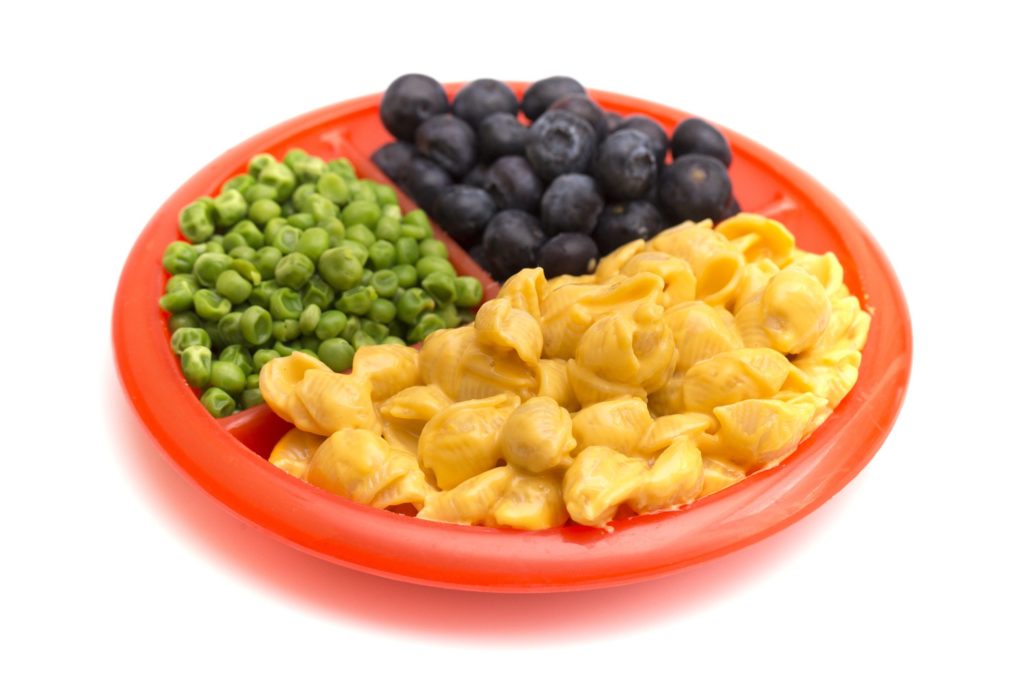
Segmented plates with pictures of recommended foods in each compartment led preschoolers to eat more vegetables, according to a research letter published Monday in the journal JAMA Pediatrics.
These lunch trays have shown similar results in elementary school kids, but not in younger children. The researchers say that this could be a tool to nudge children toward healthy habits early in life.
“It’s a really important time period in children’s lives to experience fruits and vegetables,” said report author Emily Melnick, a doctoral candidate in health and behavioral sciences at the University of Colorado Denver.
On days when kids used the plates, they served themselves nearly 14 grams more vegetables per day on average — and ate about 7.5 grams more — than when using their usual white plates. This means they ate an additional portion the size of a baby carrot or two, Melnick estimated.
However, Roseanne Lesack, a child behavioral psychologist who oversees a feeding disorders clinic at Nova Southeastern University in Florida, noted that “There’s no magic bullet, and this [study] is looking for that magic bullet.
“The food culture in America is not the strongest in terms of automatically integrating healthful food,” said Lesack, who was not involved in the research. “Parents are really stressed out about what to do.”
Children ages 4 to 8 should be eating in the vicinity of 1½ cups of vegetables daily, perhaps more depending on their physical activity, according to the US Department of Agriculture, whose MyPlate provided the basis for the design used in the study.
In the end, 7.5 grams does not an extra serving make, Melnick said — but it does “signify a willingness to take some more fruits and vegetables,” which other research suggests could be associated with a greater preference for the healthy stuff later in life, she pointed out.
Lesack said it’s unclear what that threshold might be, but “I’m always a fan of visual supports and visual aids and modeling what appropriate behavior should look like.”
Lesack, a mother and a vegetarian, said that exposing kids to healthy foods and deciding “what kind of food culture you create in your home” might be one of the most important things parents do for their children’s healthy eating habits.
“In my house, we know that it’s not really a meal if there’s not a salad,” she said.
Melnick’s small study observed 235 kids at a preschool in Arvada, Colorado, with an average age of 3.8 years. The key increase in kids eating vegetables happened on just one day in the intervention — when the menu happened to include cucumbers and carrots but no fruits. (On the other two days, the school served broccoli, Melnick said, but she was unable to determine whether or how these particular vegetables influenced the results.)
The study also found that kids did not eat significantly more fruits with the segmented plate, which the report says could be a “ceiling effect.”
“They were already consuming the majority of the fruits made available at lunchtime when we went in initially, but they were only taking about 65% of the vegetables in the bowls. So there was more room for improvement,” Melnick said.
This alone was pleasantly surprising to Lesack: that kids so young “were already choosing fruits and vegetables to put on their plate.”
An earlier CDC report showed that children weren’t eating enough fruits and veggies between 2003 and 2010, and only fruit intake trended upward during that time.
Other research has shown that marketing tactics such as banners or commercials may increase the likelihood of a child choosing to eat vegetables at lunch.
Another study published last week suggested that pressuring picky eaters has “no effect, good or bad, on picky eating or weight in this population,” said that study’s author, pediatrician Dr. Julie Lumeng, a research professor at the University of Michigan’s Center for Human Growth and Development.
Melnick has also worked on more long-term nutrition education programs in schools. However, these yearlong programs are more time-consuming and labor-intensive than the study at hand, she noted.
“It’s really interesting to see that something as simple as introducing a plate can potentially have an influence on children’s consumption patterns,” she said.
For Lesack, it’s a question of what policies might follow.
“Where do we put our resources?” she asked. “Are there a million things that could probably get a kid to eat a baby carrot or two? Probably. Is it worth it to spend a million dollars by a school district to buy plates with carrots and watermelons painted on them? Probably not.”
Melnick said it wasn’t just the kids who used the plates.
“The teachers just loved them in terms of having conversations with kids about foods and food groups … and what your plate should look like,” she said.
“It was a fun educational experience.”
























